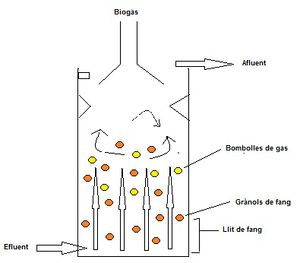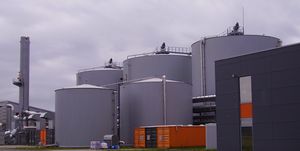Methanogenic Anaerobic Digestion of Wastewater: Difference between revisions
| Line 26: | Line 26: | ||
==Microbiology of Methane Digestion== | ==Microbiology of Methane Digestion== | ||
The microorganisms involved in methanogenic digestion work in synergy, where one group of bacteria serves as the substrate for another group, thus the four-step process of converting wastewater into methane and carbon dioxide is a chain process, in which many complex biological reactions that run in parallel.[http://www2.lwr.kth.se/Forskningsprojekt/Polishproject/rep16/MrowiecSuschka.pdf < | The microorganisms involved in methanogenic digestion work in synergy, where one group of bacteria serves as the substrate for another group, thus the four-step process of converting wastewater into methane and carbon dioxide is a chain process, in which many complex biological reactions that run in parallel.[http://www2.lwr.kth.se/Forskningsprojekt/Polishproject/rep16/MrowiecSuschka.pdf <sup>6</sup>] This is unlike aerobic processes, where only a single microorganism is needed for the degradation of wastewater. [http://www.fao.org/docrep/t0541e/t0541e08.htm <sup>7</sup>] | ||
====Hydrolyzing and Fermenting Bacteria==== | ====Hydrolyzing and Fermenting Bacteria==== | ||
"The microbiology of methane digestion has been examined intensively in the last decade. It has been established that three physiological groups of bacteria are involved in the anaerobic conversion of organic materials to methane. The first group, of hydrolyzing and fermenting bacteria, converts complex organic materials to fatty acids, alcohols, carbon dioxide, ammonia and hydrogen." | "The microbiology of methane digestion has been examined intensively in the last decade. It has been established that three physiological groups of bacteria are involved in the anaerobic conversion of organic materials to methane. The first group, of hydrolyzing and fermenting bacteria, converts complex organic materials to fatty acids, alcohols, carbon dioxide, ammonia and hydrogen." | ||
Revision as of 03:07, 1 April 2015
In the present day and age, there is a large emphasis on green technology and environmental sustainability. For sustainability to be achieved, the amount of pollution generated must be reduced, and society must become less dependent on fossil fuels as its main source of energy.1 These two goals can be achieved concurrently via the treatment of wastewater. Wastewaters contain high concentrations of degradable organic material which, when processed, produce valuable bioenergy or biochemicals.1 Wastewater treatment methods vary, but include methanogenic anaerobic digestion, biological hydrogen production, microbial fuel cells, an fermentation for production of valuable products.1
This page focuses on methanogenic anaerobic digestion of wastewater, and how biomass is used to generate valuable products, such as electricity.
Types of Methanogenic Anaerobic Digestion


Digestion of organic matter in wastewater by methanogenic anaerobic methods is popular because it has “high organic removal rates, low energy-input requirements, energy production, and low sludge production.”1 Because anaerobic treatment methods do not require the input of oxygen, it is also more cost efficient, particularly in tropical environments, where methanogenic bacteria thrive.6 The conversion of organic material present in wastewater to methane follows a four-step process. First, fermentative bacteria hydrolyze complex organic polymers, such as proteins, polysaccharides, and lipids, to amino acids, sugars, and fatty acids. These monomers are then fermented to intermediates containing a mix of organic alcohols and acids. Acetogenesis further oxidizes the intermediates to acetic acid, hydrogen, and carbon dioxide via hydrogen-producing acetogenic bacteria. More acetate is produced by acetogens and homoacetogens using the hydrogen and carbon dioxide produced in the previous step. Lastly, methanogenesis uses acetoclastic methanogens to convert acetate into methane and carbon dioxide.1
Methane produced from anaerobic digestion is most often used as an on-site fuel source for heating or electricity production using fuel cells, making it a "net positive energy" process.1 Additionally, by converting it to methanol, methane can be used in the production of biodiesel.2
Three key technologies that utilize methanogenic anaerobic digestion are the upflow anaerobic sludge blanket reactor, anaerobic migrating blanket reactor, and anaerobic sequencing batch reactor.
Upflow Anaerobic Sludge Blanket (UASB) Reactor
The UASB reactor consists of a single vessel, where wastewater enters from the bottom and flows upward into the sludge granules, which filters out organic material, and results in the production of biogas and clarified effluent.3 The sludge blanket is an aggregation of microbes that degrade the organic matter in wastewater, producing methane and carbon dioxide gases in the process. Sludge granules do not mix with the clarified effluent because their weights give them "good settling characteristics,"1 and the reactor has sloped walls to deflect any material that reaches the top--this is known as a gas-solids-separation system.35 Treated water is extracted from the top of the tank.
Advantages of UASBs include low energy requirement, low operation and maintenance costs, low sludge production, resource recovery from biogas production, and high reduction of organic matter.4 It is predicted that the pay back period for UASB technology is less than 3 years.4 UASBs are able to reduce the chemical oxygen demand (COD), a measure of water quality, by 80-90%, thus demonstrating its high organic removal rates.3 Studies have found UASBs to be most effective in the treatment of wastewater from breweries, distellery, pulp and paper, and food processing industries.4
Anaerobic Migrating Blanket Reactor (AMBR)
The anaerobic migrating blanket reactor (AMBR) is a continuously fed, staged reactor developed in response to the need for treatment of wastewater at small- to medium-sized industries. Unlike UASBs, AMBRs do not require gas-solids-separation and feed-distribution systems.5 Instead of an upflow pattern, wastewater flows in horizontally from one end, and effluent leaves from the other end.5 Gentle mixing is required to maintain contact between the substrate and biomass.5 In each compartment are microorganisms that interact with the substrate, thus filtering the wastewater.5 As water flows through each compartment, the substrate concentration decreases, so the final compartment serves as "an internal clarifier preventing biomass loss in the effluent."5 The horizontal flow causes migration of the biomass from the first compartment to the last compartment. In order to prevent excess biomass buildup in the last compartment, the flow is periodically reversed--the last compartment becomes the 5
Because of its dynamic flow, AMBRs have been found to have higher organic removal wastes than UASBs.1
Anaerobic Sequencing Batch Reactor (ASBR)
Similar to UASBs, anaerobic sequencing batch reactors (ASBRs) only have a single vessel. The vessel contains microorganisms that are mixed with the waste water. Once the biomass settles, the clarified effluent is withdrawn from the reactor.1 ASBRs have been proven to be highly effective for agricultural wastewater.1
Microbiology of Methane Digestion
The microorganisms involved in methanogenic digestion work in synergy, where one group of bacteria serves as the substrate for another group, thus the four-step process of converting wastewater into methane and carbon dioxide is a chain process, in which many complex biological reactions that run in parallel.6 This is unlike aerobic processes, where only a single microorganism is needed for the degradation of wastewater. 7
Hydrolyzing and Fermenting Bacteria
"The microbiology of methane digestion has been examined intensively in the last decade. It has been established that three physiological groups of bacteria are involved in the anaerobic conversion of organic materials to methane. The first group, of hydrolyzing and fermenting bacteria, converts complex organic materials to fatty acids, alcohols, carbon dioxide, ammonia and hydrogen."
Hydrogen-Producing Acetogenic Bacteria
"The second group of hydrogen producing acetogenic bacteria converts the products of the first group into hydrogen, carbon dioxide and acetic acid."
Methane Forming Bacteria
"The third group consists of methane forming bacteria, converting hydrogen and carbon dioxide or acetate to methane."
Conversion of Methane into Useful Products
Further Reading
References
1. Angenent L., Karim K., Al-Dahhan M., Wrenn B., Domiguez-Espinosa R. (2004). Production of bioenergy and biochemical from industrial and agricultural wastewater. Trends Biot., 22(9): 477-485.
2. Witt, P.M. and Schmidt, L.D. (1996) Effect of flow rate on the partial oxidation of methane and ethane. J catal. 163: 465-475
3. Upflow Anaerobic Sludge Blanket Reactor. Akvopedia.
4. Tare V. and Nema A. UASB technology - expectations and reality. Dept. of Env. Engg., IITT Kanpur, India
5. Angenent L.T. and Sung S. (2001). Development of anaerobic migrating blanket reactor (AMBR), a novel anaerobic treatment system. Wat. Res., 35(7):1739-1747
6. Mrowiec B. and Suschka J. Anaerobic Wastewater Treatment Process. University of Bielsko-Biala.
7.
Edited by Yenfang Koh, a student of Suzanne Kern in BIOL168L (Microbiology) in The Keck Science Department of the Claremont Colleges Spring 2015.
